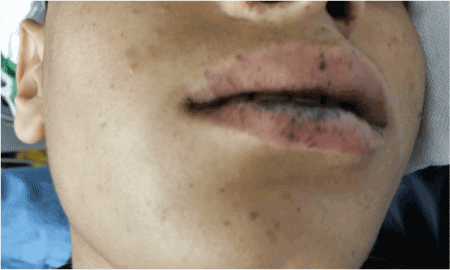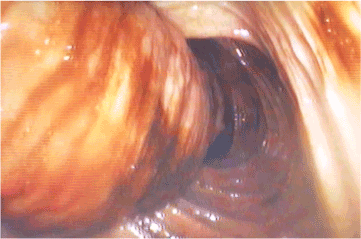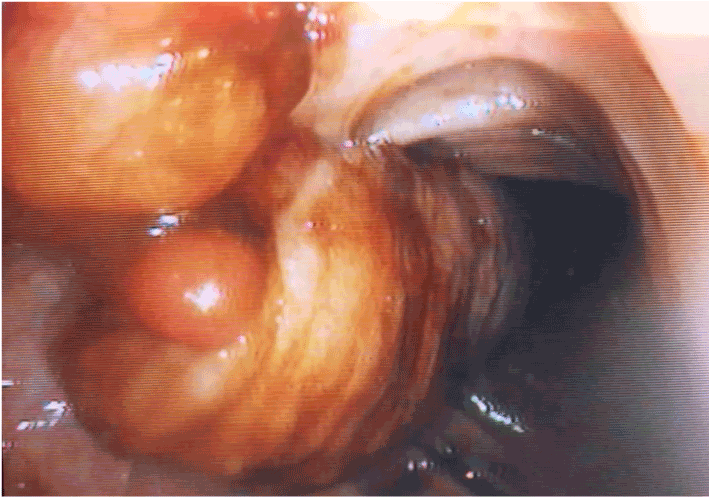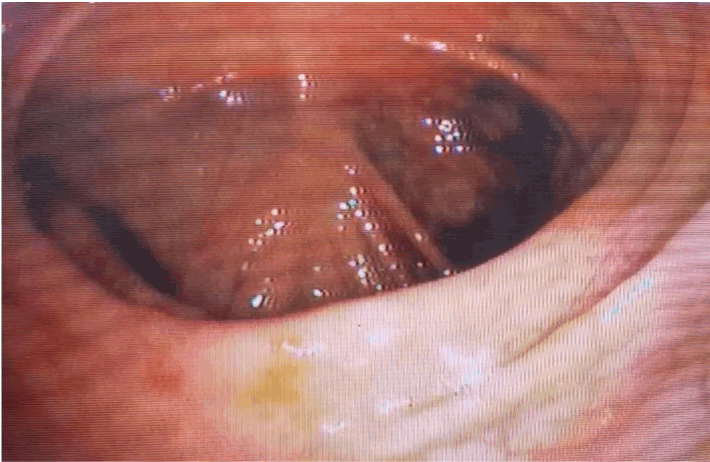A 19-years- old male previously diagnosed as Peutz-Jeghers syndrome (PJS) was referred to our center complaining of bleeding per rectum for colonoscopy and polypectomy. Clinical examination was unremarkable except for labial hyperpigmentation characteristic of PJS [Figure 1]. Colonoscopic examination showed an invaginated ileum into ascending colon [Figure 2] with a large polyp at the tip of intussusceptum [Figure 3]. Snare polypectomy was not done as the duration of intussusceptions was unknown which carries high risk of perforation occurring in a background of chronic tissue ischemia. Colonoscopic air reduction was performed and invaginated ileum with the polyp was retracted to the ileoceal valve [Figure 4].

Figure 1. Labial hyperpigmentation characteristic of PJS.

Figure 2. An invaginated ileum into ascending colon.

Figure 3. A large polyp at the tip of intussusceptum.

Figure 4. Invaginated ileum with the polyp retracted to the ileoceal valve.
PJS is a rare autosomal dominant disorder characterized by gastrointestinal hamartomatous polyps and mucocutaneous pigmentation [1]. The polyps of PJS have been reported to cause bleeding in 14% of patients. However, adult intussusception is relatively rare; only 5% of cases are in adults [2]. Most surgeons accept that adult intussusception requires surgical intervention. However, in patients with a risk of a short bowel syndrome due to multiple small intestinal polyps causing intussusception, such as PJS, a combined approach with limited intestinal resections and multiple snare polypectomies should be mandatory [3]. Our patient remained asymptomatic for 2 weeks after reduction and was referred to another center for enteroscopic polypectomy which is not available at our center.
Nil.
None declared.
- Beggs AD, Latchford AR, Vasen HF, Moslein G, Alonso A, et al. (2010) Peutz-Jeghers syndrome: a systematic review and recommendations for management. Gut 59: 975-986. [Crossref]
- Thakker HH, Joshi A, Deshpande A (2009) Peutz-Jegher’s syndrome presenting as jejunoileal intussusception in an adult male: a case report. Cases J 2: 8865-8868. [Crossref]
- Lin BC, Lien JM, Chen RJ, Fang JF, Wong YC (2000) Combined endoscopic and surgical treatment for the polyposis of Peutz-Jeghers syndrome. Surg Endosc 14: 1185-1187. [Crossref]
Editorial Information
Article Type
Case Image Article
Publication history
Received date: November 2, 2016
Accepted date: November 3, 2016
Published date: November 4, 2016
Copyright
© 2016 Altonbary AY. This is an open-access article distributed under the terms of the Creative Commons Attribution License, which permits unrestricted use, distribution, and reproduction in any medium, provided the original author and source are credited.
Citation
Altonbary AY (2016) A rare colonoscopic finding in adult male with Peutz-Jeghers syndrome. Glob Imaging Insights 1: DOI: 10.15761/GII.1000102
Corresponding author
Ahmed Youssef Altonbary
Department of Hepatology and Gastroenterology, Mansoura specialized medical hospital, Mansoura University, Egypt, Tel: +201005100091
E-mail : a.tonbary@gmail.com

Figure 1. Labial hyperpigmentation characteristic of PJS.

Figure 2. An invaginated ileum into ascending colon.

Figure 3. A large polyp at the tip of intussusceptum.

Figure 4. Invaginated ileum with the polyp retracted to the ileoceal valve.




